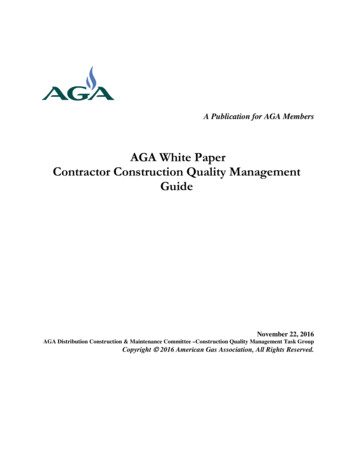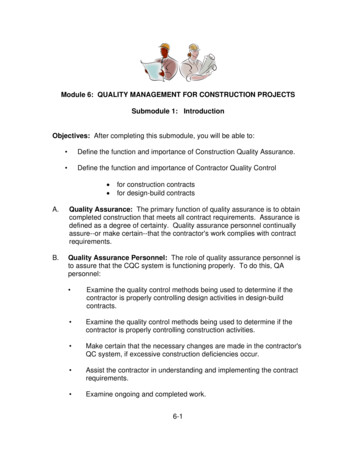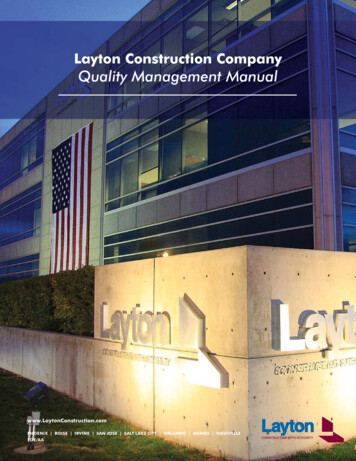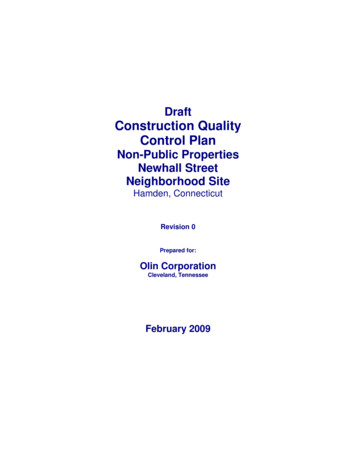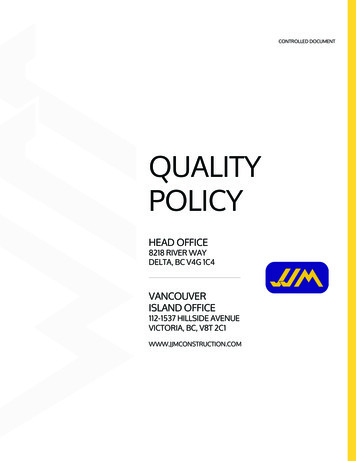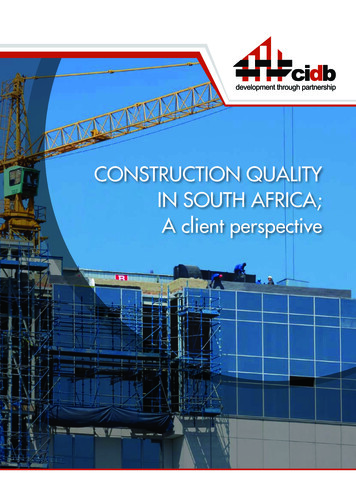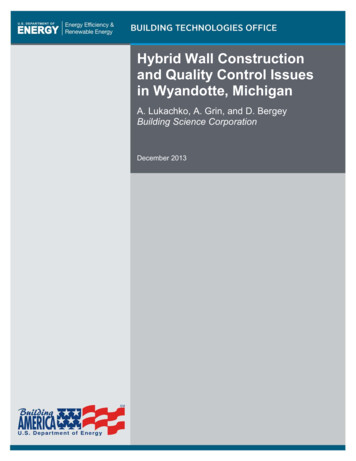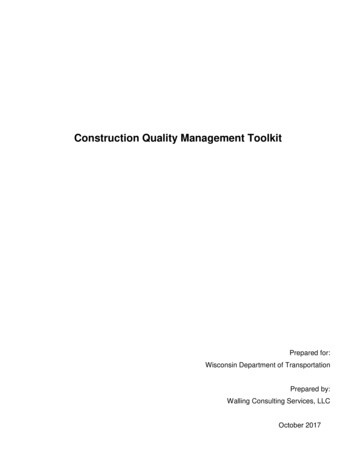
Transcription
Construction Quality Management ToolkitPrepared for:Wisconsin Department of TransportationPrepared by:Walling Consulting Services, LLCOctober 2017
Table of ContentsIntroduction 1Approach 2What is Quality .3Construction Quality Management ToolboxToolbox Preface .5Roles and Responsibilities 5List of Acronyms .7Documentation Focus Area .8Communications and Relationships Focus Area .20Contract Management Focus Area .29Resources Focus Area .38Testing of Focus Areas 41Roundtable Feedback on Improving Quality 44Bibliography 48i
IntroductionBackground. In 2016, the Wisconsin Department of Transportation developed and implemented aproject to obtain and evaluate data related to construction quality management.Walling Consulting Services, LLC (WCS) assisted Department staff with the development of a scalableconstruction quality management (CQM) process.The Department conducted a scan of current practices. The effort included a literature search fromagencies and construction organizations across North America, as well gathering information from aseries of a roundtable sessions across Wisconsin (see details in the Approach section).Context. The project is an example of the Department’s focus on continuous improvement, cost savings,and efficiencies.The project also builds upon the efforts of related initiatives undertaken by the Department:In addition, a meeting was held with Mortenson Construction to obtain their perspective regarding CQMfrom having worked on major projects in both horizontal (i.e. road and bridge) and vertical (i.e. building)construction. In 2013 and 2015, the Department created the Timely Decision Making Manual (TDM).Additional guidance and tools were developed to assist the project staff and contractors intheir communication efforts.Finally, the project leverages and reinforces the value of typical construction documentation resourcesincluding: Construction & Materials ManualStandard SpecificationsSupplemental SpecificationsRegion-specific documentationProject-specific documentation (i.e. plans, specifications, and other construction documents)Objective. The objective of the project was to develop a scalable construction quality managementprocess for the Department. Much like the PCEE and TDM initiatives, the end product is a toolbox; acompilation of tools designed to provide guidance and direction for project staff, consultants, andcontractors in the successful delivery of WisDOT construction projects.1
ApproachA review of current and best practices in CQM was conducted among the following entities:1. WisDOT practices (Southeast Region, Northeast Region, Southwest Region)2. Literature review, including prior best practice summaries3. Practices of other state DOT’s in the Upper Midwest4. Practices in the vertical construction industryTo address 1) above, WisDOT’s Brian Roper and Heather Sackman, together with WCS’s Van Walling,conducted focused interviews (i.e. roundtable sessions) with the following transportation entities: Federal Highway Administration – Wisconsin Division (FHWA) Wisconsin Transportation Builders Association (WTBA) WisDOTo Bureau of Project Developmento Bureau of Structureso Bureau of Technical Serviceso Northeast Regiono Southeast Freeways (Construction Team)o Southeast Regiono Southwest Region (I-39/90 Team)Initially, three focus areas were identified: Project Documentation Project Communication Contract Management EfficienciesThese focus areas were used to categorize input from the review of current and best practices as wellas the various roundtables could be categorized. As expected, the focus area descriptions evolvedthroughout the process into the following: Documentation Communications and Relationships Contract Management ResourcesIndividual elements and details were identified for each of the four focus areas. A tabular format utilizinga “What, When, Who, How, and Why” approach was developed. A High/Medium priority of the variouselements was applied.The four focus areas were then tested on a recently completed WisDOT construction project with inputfrom the project team. The object was to identify to what extent the CQM elements were utilized or ifother elements should be added to the CQM toolbox.Research was conducted to address items 2) and 3); the resulting list of sources can be found in theBibliography. For the most part, these documents concentrated on the design process or had a strongemphasis on construction materials testing rather than addressing the “big picture” of CQM; i.e. “did theproject conform to industry and stakeholder requirements”? Those documents providing the greatestvalue with respect to WisDOT’s CQM effort included those from Virginia DOT and the Federal TransitAdministration.2
For item 4), a meeting was held with Mortenson Construction to obtain their perspective regarding CQMfrom having worked on major projects in both horizontal (i.e. road and bridge) and vertical (i.e. building)construction.What is Quality?In the conduct of the literature search for this project, many definitions were found for the terms “quality”,“quality assurance” and “quality control”. Fortunately, the vast majority of the definitions were similar,given that the emphasis of their respective reports were the construction of transportation infrastructure.Here are some representative examples:Quality. (1) The degree of excellence of a product or service. (2) The degree to which a product or servicesatisfies the needs of a specific customer. (3) The degree to which a product or service conforms with agiven requirement.Transportation Research Circular, Number E-C173, June 2013AASHTO defines QA as “(1) All those planned and systematic actions necessary to provide confidencethat a product or facility will perform satisfactorily in service, or (2) making sure the quality of a product iswhat it should be.”FHWA’s Transportation Construction Quality Assurance Reference Manual defines QC as “The systemused by a contractor party to monitor, assess, and adjust their production or placement processes toensure that the final product will meet the specified level of quality.”Construction Quality Assurance for Design-Build Highway Project,FHWA Publication No. FHWA-HRT-12-039, April 2012In the conduct of the roundtable discussions used to gather input from various entities involved in theconstruction of transportation infrastructure in Wisconsin, the response (as shown below) were quitevaried. It should be noted that the meeting facilitators were not asking for definitions, but more of wordassociation, or “what comes to mind when you hear the word quality?”3
What is Quality? Good decision makingRequires consensus between contractor and WisDOT staffRelationshipsVery good product for reasonable costMeets specificationsNot just materials but workmanship as well; it’s a manufacturing processWhen work effort is integrated between WisDOT, contractor, etc shared responsibilitiesGetting both sides to buy in and understand benefits to themImportance of crew; same company can perform drastically different work on different projectsQuality of productCost (value)Meeting what is in specsHappy ownerOn time, on budgetTesting assures qualityWeekly meetingsDifferent definitions for WisDOT and contractorNeed to have good plansEngaged reviews; not just checking boxesBudgetProductScheduleStaffSafetyPublic perceptionAcceptable to WisDOTCompleted in safe mannerAnd for some, “how does it look?”Have to balance consistency and reasoningDurable, long lasting productConsistency in administration and productMeeting intent of plan (even if plan is not specific in a given area)ScheduleBudget integrity; on budget or rationale for exceedingDon’t do the wrong thing just to stay within budget (i.e. avoiding EBS)Meet stakeholder expectationsPrudent use of change order budgetSafety; culture change as a result of Owner Controlled Insurance ProgramMinimize surprises for management; provide problems and proposed or actual solutionsHow did contractor perform in face of incomplete plan, bad weather, etc.Compliance with contract documentsCustomer success factorsPeople, process, tools put in place to ensure an expected outcome is met in an expedited,repeatable way4
In some of the roundtables, the facilitators asked for the participants to respond to “how do we buildquality into construction projects?” Their response are shown below, ProcessesCommunicationClear expectations between team and contractorNeed to know plans and specifications thoroughlyNeed to be in right place at the right timeBe in rhythm with the contractorHave knowledge about what contractor intends to do and the consequencesThe questions and subsequent discussion allowed the roundtable participants 1) to express theirinterpretation of quality on WisDOT construction projects, 2) to hear others interpretations and mostimportantly, 3) to establish the context for the specific focus area questions that followed.Toolbox PrefaceThe project team reviewed and assigned all the feedback received at the roundtable sessions.Individual elements were identified for each of the four focus areas: Documentation Communications and Relationships Contract Management ResourcesDetails were added for each element. A tabular format utilizing a “What, When, Who, How, and Why”approach was developed to provide a tool that is easy to understand and use. Prioritization of the variouselements was addressed on a High (depicted with green highlighting) and Medium (depicted withblue highlighting) basis.A guiding principle throughout the project was to provide a CQM toolbox that would be scalable to thetype, size, and complexity of all WisDOT construction projects all across the state. While many of thefocus area elements were used on mega and major projects, these elements are scalable so that thetoolbox has value to all users.Roles and ResponsibilitiesThroughout the roundtable sessions, there were many discussions regarding the relationships amongvarious entities. Accordingly, “Communications and Relationships” and “Roles and Responsibilities” wereoriginally seen as two of the focus areas to be addressed the CQM toolbox. After further discussion, itwas determined that “Roles”, and more specifically, “Roles and Responsibilities” was more of afoundational component underlying the four other focus areas.5
In those cases where differences of opinion or conflict develop between the various entities, it is often theresult of a misunderstanding of the role and responsibility of one’s own entity, or that of the role andresponsibility of other entities. Clarification of roles and responsibilities at the beginning of a project, andreinforcement throughout the project, will go a long way to optimize partnering.Presented here is an overview of the “Roles and Responsibilities” for four different entities involved in theconstruction of WisDOT’s transportation infrastructure.FHWA Wisconsin Division Office Review and approve main processes(specifications, FDM, CMM) Review construction Review contract status Identify program-wide quality issues forfederal compliance Review construction inspection report Prepare annual construction inspectionreport Report out at WTBA, ACEC, and RegionconferencesWisDOT Statewide Bureaus Review and approve plans and specs Review construction Review contract status Identify quality issues Review construction inspection report Prepare annual construction inspectionreport Report out at WTBA, ACEC, and Regionconferences Oversee EEO, prevailing wage and DBEcommitment statusWisDOT Region Oversee contractor work in progress andoverall project schedule Inspect and review construction Review submittals Manage RFI’s Document and resolve issues and disputes Measure quantities, prepare estimates,process payments Develop and oversee work zone safetymeasures for traveling public Oversee public relations Administer contract documents Identify quality issues Obtain required permits and coordinate withstate and local agencies Coordinate with local businesses, residents,and other stakeholders as appropriateContractor Perform construction per plans, specialprovisions, standard specifications, CMM,and other industry standards as appropriate Develop and implement QC processes andprocedures Develop and implement safety measures forcontractor operations Implement work zone traffic control fortraveling public Develop and manage project schedule Develop RFI’s Identify project issues (e.g. quality, safety,schedule, constructability, staging, etc.) anddevelop potential solutions Coordinate with subcontractors Coordinate with local businesses, residents,and other stakeholders as appropriate Obtain required permits and coordinate withstate and local agencies as required incontract Coordinate with FHWA and WisDOT Maintain EEO, prevailing wage and DBEdocumentation6
List of AcronymsBOS – Bureau of StructuresRFI - Request for InformationBPD – Bureau of Project DevelopmentRFP – Request for PriceBTS – Bureau of Technical ServicesROM – Rough Order of MagnitudeCMJ – Contract Modification JustificationTDM - Timely Decision Making (Manual)CMM – Construction & Materials ManualWAF - Work Authorization FormCPM – Critical Path MethodWTBA – Wisconsin Transportation BuildersAssociationCQI – Construction Quality IndexCQM – Construction Quality ManagementCRI – Cost Reduction IncentiveDIN – Design Issue NoticeFDM – Facilities Development ManualFHWA – Federal Highway AdministrationIDR – Inspector’s Daily ReportMUTCD – Manual on Uni
A guiding principle throughout the project was to provide a CQM toolbox that would be scalable to the type, size, and complexity of all WisDOT construction projects all across the state. While many of the focus area elements were used on mega and major projects, these elements are scalable so that the toolbox has value to all users.



